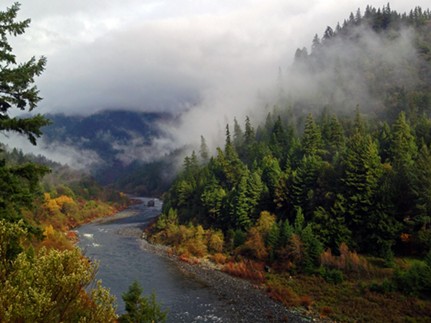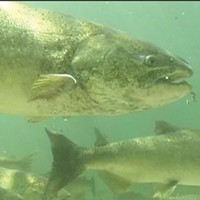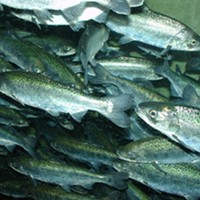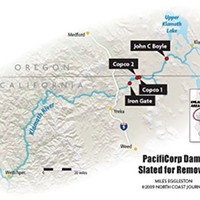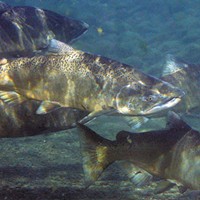Monday, April 10, 2017
Karuk Tribe Restricts Fishing
Posted By Linda Stansberry @lcstansberry on Mon, Apr 10, 2017 at 12:09 PM
The Karuk Tribe announced today that it is restricting subsistence fishing on the Klamath River, a reaction to predictions that this year's run of Klamath Chinook salmon will be the smallest in history. On March 25, the Yurok Tribe announced it would suspend commercial fishing for the second year in a row. The Yurok Tribe cited the ill health of the river and ocean as factors in poor salmon returns, and both tribes added their hopes for the future removal of the Klamath dams.
According to a press release sent out by Craig Tucker, a natural resources policy advocate with the
Karuk Tribe, the tribe will allow the harvest of only 200 Chinook salmon for "subsistence and ceremonial purposes."
Reached by phone today, Tucker explained that traditionally Karuk tribal members who host a dance are obligated to feed those who show up, and have relationships with fishermen who supply them with salmon. This, and subsistence fishing, will be the only permitted harvest of the áama (Áama is the Karuk term for Chinook salmon).
Tucker added that the Pacific District Fisheries Management Committee would also probably release its recommendations for the Klamath today, but as the Karuk Tribe does not have a federally recognized fishing right, it would likely not be included in that announcement. The tribe regulates itself in relation to fishing, and the traditional method of harvesting the salmon below Ishi Pishi falls allows many of the fish to spawn upstream. Tribal members say the act of fishing is an important cultural touchstone for Karuk youth.
"Ishi Pishi is more than a fishery, it's a place where elders teach the youth how to feed their families, how to work hard, and to be thankful for the gifts the creator has bestowed upon us. Losing this opportunity is a cultural tragedy,” said Leaf Hillman, the tribe's natural resources director, in the press release.
This year the Pacific Fisheries Management Council released its predicted Chinook salmon returns for 2017 at 11,000 fish — the lowest on record.
From the Karuk Tribe:
According to a press release sent out by Craig Tucker, a natural resources policy advocate with the
Karuk Tribe, the tribe will allow the harvest of only 200 Chinook salmon for "subsistence and ceremonial purposes."
Reached by phone today, Tucker explained that traditionally Karuk tribal members who host a dance are obligated to feed those who show up, and have relationships with fishermen who supply them with salmon. This, and subsistence fishing, will be the only permitted harvest of the áama (Áama is the Karuk term for Chinook salmon).
Tucker added that the Pacific District Fisheries Management Committee would also probably release its recommendations for the Klamath today, but as the Karuk Tribe does not have a federally recognized fishing right, it would likely not be included in that announcement. The tribe regulates itself in relation to fishing, and the traditional method of harvesting the salmon below Ishi Pishi falls allows many of the fish to spawn upstream. Tribal members say the act of fishing is an important cultural touchstone for Karuk youth.
"Ishi Pishi is more than a fishery, it's a place where elders teach the youth how to feed their families, how to work hard, and to be thankful for the gifts the creator has bestowed upon us. Losing this opportunity is a cultural tragedy,” said Leaf Hillman, the tribe's natural resources director, in the press release.
This year the Pacific Fisheries Management Council released its predicted Chinook salmon returns for 2017 at 11,000 fish — the lowest on record.
From the Karuk Tribe:
The Karuk Tribal Council has taken the unprecedented step of placing restrictions on subsistence fishing by Tribal Members for the first time in history.
“It’s my saddest day as Chairman,” said Karuk Tribal Chairman Russell ‘Buster’ Attebery, “this is the first time in our history that we have imposed limits on traditional dip net fishermen working to feed their extended families and tribal elders.”
The Tribe will allow the harvest of 200 Chinook salmon for subsistence and ceremonial purposes. Typically, Karuk fishing requires little in the way of regulation due to the fishing method. Karuk fishermen use a traditional dip net about 12 feet long to scoop out salmon from behind rocks in the rapids below Ishi Pishi Falls “You can only catch a very small percentage of the fish that are moving through the falls with dip-nets. Our fishing method limits our take so as to ensure plenty of fish make it up- stream to spawn,” explains Attebery.
This year’s run of Klamath Chinook salmon is projected to be the smallest in history- 11,000 fish. This is about 10% of average for the last 3 decades. Before colonialization, scientists estimate over 1.2 million salmon returned to the Klamath annually.
The Karuk once harvested fish at over 120 village sites along the middle Klamath and Salmon Rivers. Today, the Tribe is limited to a single site, Ishi Pishi Falls near present day Somes Bar, CA. It’s hard work, operating a 12 foot dip net in the midst of the treacherous Ishi Pishi Falls. Harvested salmon can weigh upwards of 40 pounds and are packed out on foot by young men aspiring to one day work the nets themselves. “When the fish are running, it’s a stunning site. Ishi Pishi is more than a fishery, its place where elders teach the youth how to feed their families, how to work hard, and to be thankful for the gifts the creator has bestowed upon us. Losing this opportunity is a cultural tragedy,” explains Leaf Hillman, Natural Resources Director for the Tribe.
Despite the tragedy, the Karuk remain optimistic about the future. “PacifiCorp’s dam removal plan gives me hope for the future. They know that dam removal is in the best economic interests of their shareholders and customers. And there’s no doubt it is in the best interest of the Karuk Tribe,” explains Karuk Councilman Josh Saxon.
The Klamath dams generate relatively small amounts of electricity, provide no irrigation diversions, and offer little in the way of flood control. The company recently proposed a dam removal plan to the Federal Energy Regulatory Commission. If approved, dam removal would occur in 2020.
The Karuk hope the fish can hold out that long. “We’re having a great water year now. I hope the áama (Áama is the Karuk term for Chinook or King Salmon) can hang on until we can remove these dams and give them fighting chance,” concludes Saxon.
Speaking of...
-
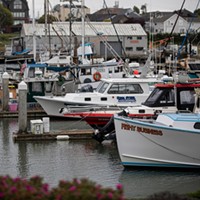
California Salmon Fishing Banned for Second Year in Row
Apr 15, 2024 -

'Our Food is Our Medicine'
Mar 28, 2024 -

The Klamath River Salmon Die-off Was Tragic. Was it Predictable?
Mar 8, 2024 - More »
Comments
Showing 1-1 of 1
Readers also liked…
more from the author
-
Lobster Girl Finds the Beat
- Nov 9, 2023
-
Tales from the CryptTok
- Oct 26, 2023
- More »
